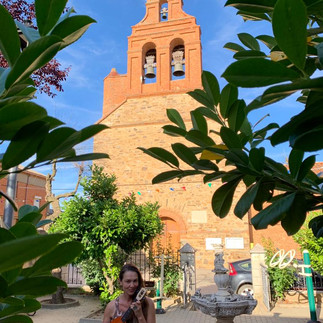A Tale of two Storks (A Love Story): Villar de Mazarife, Spain (León)
- kristina jacobsen
- Sep 20, 2022
- 3 min read
Updated: Sep 24, 2022

On day 10 of walking the Camino de Santiago in northern Spain this summer, we slept in the small village of Villar de Mazarife. The stay was memorable for several reasons, among them an extremely eccentric but welcoming chain-smoking host/masseur, and an amazing multi-course meal of organic vegetarian paella, Priete de Pecudo (local red wine or ‘tinto’) and our very-first (of many!) torta de Santiago (Spanish almond torte). But most memorable, three months later, is the story of the storks. These giant storks build their nests near the belltowers of churches all across this region of Spain., known as León.
When we arrived in Villar de Mazarife, we wanted to learn some local history (one of the dangers of the camino is that you spend so much time walking each day, and are so tired when you arrive, that you have no energy left to explore the new place you are in). Late in the afternoon, after our mandatory post-lunch nap, we walked into the local Catholic church. Immediately, the woman volunteering there, Pilar Fernández, began to tell us the story of the storks.
Storks mate for life, and migrate from Spain to Africa, each October. Each spring, they return to Spain, always to the same nest, and always to the same village (with climate change, some storks also now stay in Spain, year-round). They are, in this sense, the quintessential definition of “faithful.” Stork nests are massive, weighing up to 1400 pounds, and are a prominent part of the iconography of northern Spain.

It’s an anomaly to see a church without a stork nest! Storks also have a long lifespan, living for up to 20 years, on average. After migrating, the male stork typically returns first, and guards the nest until his female mate returns.
In Villar de Mazarife, there once was a pair of storks that had built their nest together on the belltower of the Catholic church. The village residents needed to rebuild the church—it was old and falling apart—and so they built a new church, belltower and all. While the old belltower remained standing, the storknest on top of it, the storks opted to rebuild their nest on the belltower of the new church. But, in the process of rebuilding, the female stork tragically got her wing caught in the crucifix of the church. She was pinned to the crucifix. Village residents protested and asked for help from the municipal authorities to assist the stork, but, as Pilar writes, “this is Spain!” And there is a lot of bureacracy and hemming and hawing. So no one came. Over a series of agonizing days, her wing trapped, the female stork died, her mate vocalizing out loud in agony.
Her mate returned the next year, back to the same nest, sitting and looking to the sky, waiting for her to return. He became very withdrawn, would not let any other birds approach the nest, and lost a lot of weight. Storks are social animals, and need the socialization of their mates in order to survive. The residents of Villar de Mazarife were concerned he would not survive without his mate.


In the fall, he migrated south, and returned again the next spring, to the same, empty nest. This time, however, he was being shyly observed by a younger, female stork from an adjacent tower. Over a series of weeks, they began visiting each other’s belltowers, and, eventually, he permitted her to approach his nest as well. Then they began rebuilding his nest, together. Three years later, they are still mates, and return to this same nest each spring, on the top of the church, pictured here, where Pilar told us this story.
At this point in the story, I am literally a puddle of tears, in the middle of this teeny, dark church. I am deeply moved. My partner is putting his arm around me, and Pilar reaches out and lightly touches my hand.
To me, this is a story about true love, about loss, and about resilience (I am admittedly anthropomorphizing, here). After enduring incredible trauma—I cannot even imagine what it would be like to watch my mate slowly die and be completely powerless to help—the male stork finds the strength to migrate, and to then return to the place of pain and trauma, to sit with this loss, sitting in the old nest he shared with his original mate. After taking a full year to greave, he allows his heart to open back up, and finds the way to let another stork into his nest, and his heart. I am not sure I can think of a more beautiful, or more healing story. Hearts, after being torn apart, can mend. And, in the aftermath, we can rebuild our nests. Pilar’s grandparents say that storks build their nests in churches to be closer to god or to a higher spirit. Perhaps they are right.











Who does this amazing photography and art?!